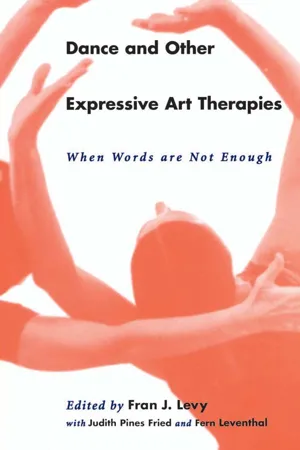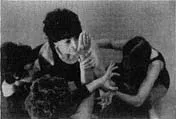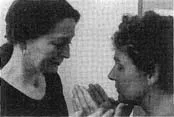![]()
_____________________________
Part 1
Adults
_____________________________
![]()
_____________________________
_____________________________
Nameless: A Case of Multiplicity
Fran J. Levy
_____________________________
The following chapter discusses the long-term treatment of a young, highly intelligent, professional woman who, in addition to severe anxiety and depression, suffers from a unique form of multiplicity. The therapy process presented unusual challenges and demands that had to be considered in every stage of the treatment. Although the patient was seen three and sometimes four times a week, the treatment was not psychoanalysis. It was psychodynamically oriented, however, and the interventions used were within the realm of a creative arts or multimodal approach to psychotherapy. The intensity and style of treatment were always determined by the presenting problems and the unusual developmental needs of the patient.1
Multiplicity
It is common for us to speak of ourselves as though we were divided into parts. “Part of me is happy but another part is lonely and sad.” “Part of me is mad at my parents but another part understands their limitations.” “At times I feel torn apart.” Such phrases are commonplace, but what does this language that refers to parts of the self really mean? Are we actually divided into distinct parts? Or is the word “part” a metaphor for conflicting and repressed feelings? If we are actually divided within ourselves, what is the impact of this division? And finally,how can we as therapists engage our patients' many parts into meaningful dialogue? In this chapter, the case of Rachel is intended to shed light on both the complex issues that contribute to fragmentation of the self and on the creative, symbolic, and empathie interventions required for the gradual unification of the self.
The term used to identify a state of fragmentation is “multiplicity” and the definition of the term includes a range from mild, imperceptible splits to distinct, discrete identities that alternate in their control of the self, that is, multiple personality disorder or MPD (Beahrs, 1982). In order for the case of Rachel and the concept of multiplicity to be understood, it is useful to look briefly at child development, particularly at issues of separation/individuation.
Separation/Sndividuation and the Development of Self
The birth of a child may be viewed as a two-stage process. Initially there is the actual birth, when the child makes its physiological separation from the mother. This birth is delineated in time and space. The second birth, which takes an unspecified amount of time and varies with each individual, is the child's psychological birth and is referred to by Mahler as the process of separation-indi-viduation (Mahler, Pine, & Bergman, 1975).
Mahler explains that having been in the womb, attached to the mother for 9 months, after birth the infant continues to feel attached, still at one with the mother, undifferentiated. When the baby is in utero there is a constant stream of biochemical information and stimuli that largely originate in the mother but is also experienced by the infant. After birth there is a change in the communication from mother to infant. The way the mother holds, looks at, and talks to the baby, her tone of voice, her gentle or rough touch, all contribute to the communication. Infants continue to feel that they are an integral part of the mother, and some feeling of emotional, physical, and intellectual connectedness continues throughout the individual's life.
All individuals mature at different rates and, although a person may become a successful adult, success does not mean that the person is fully individuated. Few of us, in fact, are either wholly attached or completely distinct. Instead, each of us falls somewhere on a complex continuum between the two extremes. The more one is attached, however, the greater the experience of fragmentation and, conversely, the more one experiences oneself as distinct from others, the greater the sense of integration (S. Levy, personal communication, May 4, 1993).
Causes of Multiplicity
There is no single cause of multiplicity. Instead, there are numerous possible causes that, when joined together, could lead to the perception of one's self as multiple.
One cause of multiplicity may be incomplete separation from parental figures. Feelings of attachment and connectedness are universal and are not necessarily dangerous to the integrity of the self. The degree to which an attachment is unhealthy can be determined by the degree to which any individual is able or unable to maintain independent thoughts, feelings, and actions. Extreme unresolved attachment to a parent may leave a person unduly vulnerable to the influence of others. Individuals with such attachments may perceive another as physically part of them. They may feel divided, torn between themselves and the other by whom they feel controlled and from whom they cannot differentiate. Because such individuals are unable to know where they end and another begins, all relationships present a potential threat to the integrity of the self.
Another cause of multiplicity may stem from the fact that we often carry into adulthood the fragments of earlier, immature selves (Freud, 1960). Popular literature refers to these fragments as “our inner selves,” or as our secret “baby” parts (Missildine, 1963). For some, such fragments are well integrated and therefore insignificant in their influence on the personality. For others, the fragments can be threatening, especially if they are ignored. In advanced stages of fragmentation, an individual may be split into distinct personalities, each with fully developed and independent needs, beliefs, memories, even illnesses (Braun, 1986; Kluft, 1983; Putnam, 1989). The personalities may alternate in their jurisdiction over the entire system of selves. When such is the case, we refer to these selves as alternate personalities, not fragments. Alternate personalities or “alters” represent a high level of organization and their etiology expands beyond, but does not exclude, incomplete separation/individuation. Individuals split in this way are diagnosed as having multiple personality disorder (MPD).
Some theorists speculating on the etiology of multiple personality trace the development of separate distinct personalities to an early childhood experience of severe and often protracted abuse. The abuse may be physical or it may be psychological. Either form can lead to a marked arrest in development in which parts of the individual split off and become alters as a way of protecting the self (Braun, 1986; Kluft, 1983; Putnam, 1989). Some of these same theorists also point to the possibility that certain individuals may be born with a biochemical predisposition toward alternating ego states or varying states of consciousness.
An important criterion that differentiates severe cases of MPD from milder forms of multiplicity is the degree to which an individual's different selves are conscious of each other. When there is little or no “co-consciousness” the diagnosis is clearly multiple personality disorder. If, however, the individual is aware of other selves and has the ability to negotiate life decisions with some degree of communication with the organizing or “host” self, the diagnosis may fall more within the realm of multiplicity or mild MPD (Beahrs, 1982).
The Arts and Multiplicity
Throughout history artists, philosophers, and scientists have understood the inherent limitations of verbal language to express all nuances of life. Therapists who work with the creative arts provide their patients with an opportunity to find an expressive language that is most natural and meaningful to them and most central to their nature. The arts allow individuals to speak through different media and the medium that is used should reflect the patient's needs in the moment. If we accept as fact that we carry pieces of our childhood with us, it is easy to understand why a variety of expressive modalities can help to elicit and clarify nonverbal experiences. We know that children tell us many things through play, art, dance, and music that they may not be able to say in words. It follows that adults, carrying aspects of their childhood with them, can also benefit from creative symbolic action.
As will be seen in the case of Rachel, a combination of movement, drawing, writing, music, and symbolic realization gave expression to both the child and the infant Rachel had within. To keep Rachel solely in a verbal mode of expression would have limited her ability to experience and nurture the very young parts of herself, the parts she came to call “The Kids.” In addition, because Rachel had not been allowed to express herself verbally as a child, she had stored many of her early feelings in art and symbol. In order for her to find these parts of herself, a number of expressive and symbolic activities were incorporated in her treatment.
As creative-art therapists we have a unique set of tools, which, when used intelligently and empathicly, help us to reach deeply into the complex weave of the human personality. By the same token, used carelessly, or without a genuine understanding and empathy for the multileveled needs of the individual, the same tools can create further fragmentation and chaos.
The Case of Rachel
Background
Rachel is a bright, psychologically astute career woman. After she became comfortable in treatment, she showed herself to be highly articulate. Her superior intelligence was apparent throughout the therapy, through our interactions, her responses to treatment, and through her ability to work in a creative and symbolic fashion. The following history was collected over a period of many years. It is comprised of Rachel's memories of her childhood together with material learned from communication with family members.
Rachel was the first born in an intact family. She had two younger brothers, 2 and 6 years her junior. Rachel said that “the boys” were her parents'favorites and that after their birth she felt ignored and like a misfit in the fami-ly. From age 7, Rachel was often left home with her mother to clean house while the boys went on “boy trips” with her father. When she went out with the family on weekends, it was often to watch the boys play ball. She believed that her mother had contempt for her and for girls in general. She recalls that her mother constantly criticized her—a memory confirmed by her brothers. “She was yelled at all the time for no reason. She was a quiet kid. We could see how sad she was. We were all afraid of our mother but Rachel got the worst of it.”
As a child Rachel was withdrawn, basically afraid of asserting herself with anyone. Trying to be “good,” she was always neat and clean, methodical, attentive to detail, and a good student. “You simply couldn't be any other way in my mother's house. Whatever my mother said, that was the way it was. Rachel reported that her mother often told her what a wonderful family she had and how lucky Rachel was to have this family. Rachel always believed her mother and this belief is what puzzled her. How could she be so unhappy in such a wonderful family? “Something must be very wrong with me” she thought.
Rachel's mother had severe mood swings that included unpredictable bursts of rage. As a result, Rachel “walked on eggshells” and was “always on the lookout to see what her mood was” so she would know how to behave. When she helped her mother in the kitchen and didn't move fast enough, her mother shoved her out of the way and berated her for being “too slow.” Her mother frequently threatened to “smash” her. Rachel remembers being shy, awkward, and overweight from the time of elementary school, always uncomfortable with herself and others. She tried hard to be pleasing but felt that nothing she did could win her mother's approval. By the time she was in high school she stopped believing that she had a wonderful family. She began to hate her mother and wanted “nothing to do with her.”
Making friends was understandably difficult for Rachel. “How could I feel good enough about myself to make friends when my mother made me feel like nothing? I had no self. I was a nobody. The friends I did make she criticized. She accused me of running after them and letting them use me.” Rachel recognized that she did let people “walk all over her.” She knew that she did it partially to win their affection and because she was afraid to speak up.
As far back as second grade, Rachel remembered looking to her female teachers as surrogate mothers. This tendency continued throughout high school. In college, however, Rachel made a “best friend” and they were inseparable. Her mother harshly ridiculed her friend and accused Rachel of being a lesbian. The accusation was deeply upsetting to Rachel whose sexuality at this time was unformed.
In spite of her struggles throughout childhood, Rachel managed to complete her college education with honors. In addition, by the time I met her she had a good position on Wall Street. Despite this evidence of success, she still felt “like a nobody,” hating her life and herself. She believed she had become professionally what her parents wanted but not what she wanted. She had once dreamed of becoming a psychotherapist and had wanted to study psychology in college but had been discouraged by her parents who pushed all of the children into business. “You simply didn't go against them.” Rachel hated the way women were treated in business. Her experience as a woman on Wall Street was reminiscent of her childhood experience. She felt left out of the “old boys club,” “different,” “invisible.”
When Rachel came to treatment she said “I can't stand living like a nobody anymore.” She wanted to be free from her mother's domination and from her feelings of self-hatred. She also recounted numerous somatic complaints she believed were part of “being uptight.” As long as she could remember she suffered from frequent stomachaches, headaches, and insomnia. She had a fear of flying so intense that it precipitated cold sweats and heart palpitations. Off and on Rachel had flirted with the idea of suicide.
Initial Sessions
Rachel first came to see me 12 years ago. She was a tall, somewhat overweight young woman, neat, clean, and on time. She stood anxiously with her head bent over, hands nervously fidgeting and shoulders raised with tension. Her speech was quiet and at times inaudible. I asked her if she'd like to sit down. She did, but after sitting briefly, got up and began to pace back and forth. The studio was a large carpeted space with chairs, large pillows, and play things. Rachel had plenty of room in which to walk back and forth. As she paced, her high-pitched speech was tense, childlike, and self-conscious. She asked several times if I wanted her to leave and wondered if she was “too much” for me. She seemed irritable. Rachel was clearly uncomfortable face to face; she was unable to sustain eye contact. Sitting across from me appeared to be an excruciatingly painful experience. She was like an animal behind bars. Eventually she described herself in just this way. “I feel like a caged animal, like I'm in a prison.” Pacing was a way to both contain and express her tension. Due to the degree of anxiety she was experiencing, we decided in the first session that she would come in twice a week. Later in treatment our contacts increased.
Approximately two weeks into treatment, aware that words were frustrating for Rachel and aware that she was not ready for expressive movement, I asked Rachel if she would like to draw. We sat together on the carpet but Rachel did not pick up the crayons. Instead, she did something she had not done before. She glanced up at me with a mischievous twinkle in her eye. On what seemed an impulse, she picked up the crayons and playfully threw them at me, looked down and laughed. I also laughed, paused silently for a moment and threw them back at her. We laughed together for the first time and Ra...



